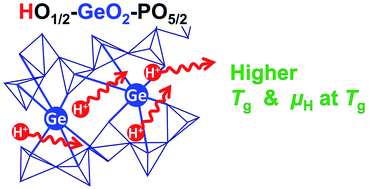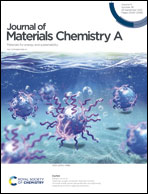Investigating the role of GeO2 in enhancing the thermal stability and proton mobility of proton-conducting phosphate glasses†
Abstract
In this study, the effect of GeO2 on the thermal stability and proton mobility (μH) of proton-conducting phosphate glasses was experimentally investigated using 22HO1/2–3NaO1/2–(12 − x)LaO3/2–xGeO2–63PO5/2 glasses. Increasing glass transition temperature (Tg) and μH at Tg were experimentally found out, when LaO3/2 was substituted with GeO2, and this behavior coincides well with the prediction obtained from a linear regression model previously proposed. Based on the glass structure and nature of a P–O bond, both enhanced Tg and μH at Tg were strongly related to the formation of heteroatomic P–O–Ge linkages. The Ge atoms are six-fold coordinated with O atoms, and they tightly bridge the (PO3−)n phosphate chains through the heteroatomic P–O–Ge linkages, resulting in rigid phosphate frameworks with higher Tg. The formation of the heteroatomic P–O–Ge linkage results in increased covalency in the P–O bond. This increases the ionicity of the O–H bond owing to the balanced electron transfer to prevent excessive decrease in electron density on the O atom in the P–O–H bond. Thus, μH at Tg increases because the increasing ionicity weakens the O–H bond. Herein, the increasing covalency in the P–O bond is discussed according to the difference in the electronegativity and atomic orbitals that contribute to the bond with an O atom between La⋯O and Ge–O bonds.



 Please wait while we load your content...
Please wait while we load your content...